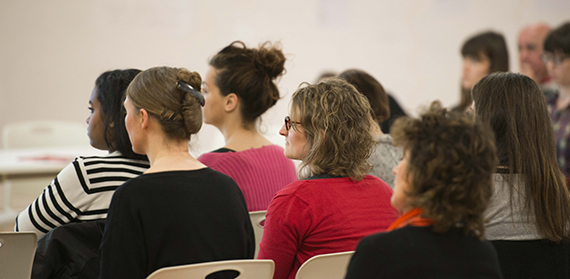 Guest Blog by Hayley Izzard – Third year Dance, Theatre and Professional Practice Student
Guest Blog by Hayley Izzard – Third year Dance, Theatre and Professional Practice Student
February 13th marked the date for a truly inspiring and thought –provoking day of seminars and lectures delivered by top professionals in the dance and digital industry, hosted by the Centre for Dance Research (C-DaRE).
The day started with keynote speaker and Digital Media expert Matthew Causey, sharing his paper named ‘The Right to be Forgotten and the Image Crimes of Digital Culture’. This paper explored the interesting issue and controversy of social media and how the debated issue of ‘identity’ sits in the virtual world. He provoked questions such as how much control do you have over your ‘identity’ in virtual media?
When re-tweeting or re-posting crimes and events of the world that is particularly personal to an individual, who is responsible for the suicides that happen as a result of circulation of these feeds?
Causey created a truly impactful argument stating that ‘the digital is a type of masking. It remains only partially deleted, the digital is never deleted.’ His argument is it still leaves a remnant; a stamp on the world wide web’s history.
There was a huge itinerary for the day, but Adrian Palka’s presentation, displaying his journey of his pilgrimage to Eastern Europe for personal reasons, stood out. There wasn’t interest, on his part, for promoting a business or getting his academia known, his intention was a personal endeavour.
Retracing his father’s steps on a journey through Sweden turned out to be an emotional and fulfilling journey for Adrian, but had an intention to be captured on camera, for digital storage. He expressed his view that his journey was a ‘digital intervention in family history’, which allowed him to ‘intervene in reality, in the ‘myth’ of the readings and memories of his father’s diary from a Swedish war.
The subject of topic delivered by Kerry Francksen Kelly was her PHD writings on Dance and Technology, looking at the perceptual shift that the dancer has to make to accommodate, professionally and creatively, to work with the question of ‘what is a body?’ on digital media, and what this means for what is now known as embodied practice.
Kerry puts forward her view that the digital ‘encompasses a presence more than live body.’ She went on to explain how companies such as MotionHouse and their piece of work, known as ‘Scattered’, portrays a dancer and an image which acts as an interruption; they both co-exist in time and space. Which means there are certain boundaries to overcome of ‘presence’, of what is seen through a screen and accuracy of how the media captures the live performance. Often is the argument in the dance industry that digital media can never truly capture the accuracy and atmosphere that the live performance entails. To focus on this ‘real’ experience, could be the next step to look into developing with technology.
Visit the C-DaRE website for more information about upcoming events and projects.
Image Credit: Photographer KoKo Zin . Licensed under kozinphotography.




Comments are disabled